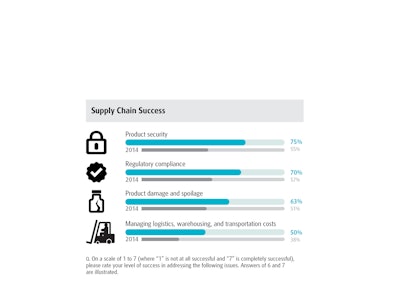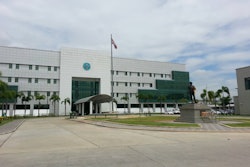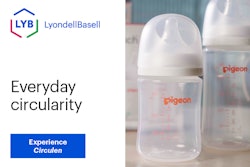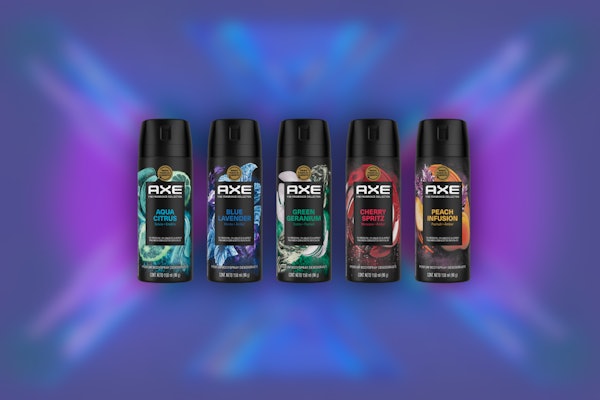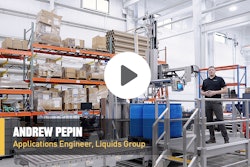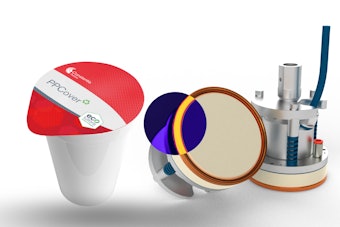The UPS 2015 Pain in the (Supply) Chain survey revealed that healthcare companies made significant strides in just one year to address some top supply chain pain points, as evidenced by the following:
• 75% of respondents reported success addressing product security vs 55% in 2014
• 70% of respondents reported success in addressing regulatory compliance vs 57% in 2014.
“What we find most interesting from this year’s survey results are the strides that healthcare companies have made in just one year to address some top issues that have faced the healthcare supply chain for decades, and we are pleased to share the strategies that firms are leveraging,” said Robin Hooker, UPS Director of Healthcare Marketing.
Despite those gains, issues remain in the healthcare supply chain. For example, the survey showed that only 50% of respondents indicated success addressing supply chain cost management. The top challenge to managing costs is rapid business growth, cited by 56%. In order to address this, healthcare logisticians see the most opportunity in optimizing their transportation costs and gaining better inventory visibility.
DSCSA makes an impact
“We see pharmaceutical companies becoming more optimistic regarding product security as they implement anti-counterfeiting initiatives as part of the U.S. Drug Supply Chain Security Act, which is a broad-based supply chain security and recall mandate," Hooker said. "The real question is how quickly will forward-looking firms reap additional business value related to inventory management by investing in systems that are not only compliant to DSCSA, but leverage the datasets for supply chain optimization."
Hooker added, “The analytics and predictive power of managing inventories and logistics flows with knowledge of potential expiry dates at the unit level enables a new level of inventory control and potential savings in expired pharma return/audit/destruction cost.”
Other key survey findings included the following:
• Physical protection from theft (46%) and poor supply chain visibility and too many supply chain hand-offs (40%) represented the biggest product security challenges
• Contingency planning is not prioritized by healthcare executives
• Partnerships are the top successful strategy healthcare companies use to address regulatory compliance, product damage/spoilage and cost management
Increased product complexity
As products continue to become more complex and in many cases require special handling, healthcare decision-makers recognize the importance of selecting higher-quality carriers, faster shipping speed and in-transit intervention capabilities needed to drive success in mitigating product damage and spoilage.
“We know that firms have viewed the variations in international regulatory guidelines as a headwind to global market access, but firms that rate themselves as successful in entering new markets leverage relationships with 3PLs that have integrated global healthcare transportation and distribution solutions," said Hooker.
The UPS executive also said, “Protecting time-and temperature-sensitive products poses challenges in global supply chains. Successful decision makers are mitigating risk of delay or temperature excursion by leveraging transportation network thermal profiling studies conducted by some integrators, as well as some of the latest shipment monitoring devices and proactive tracking and over-watch bundles that allow the transportation provider to monitor, predict, intervene and even insure products.”
Logistics and distribution partnerships were cited as the top strategy healthcare companies employed to address supply chain pain points. Partnerships with local third-party logistics providers (3PLs) were identified as the top strategy used to combat regulatory compliance challenges cited by 55%, and 74% report success addressing product damage and spoilage by partnering with a higher-quality carrier.
“Supply chain and logistics decision makers can no longer afford to develop global strategies in a vacuum," Hooker said. "Collaborative models for accessing new markets are being redefined as a result of the market complexities of healthcare supply chain regulations. Mix in the record level of M&A activity over the past few years and you multiply that complexity. Now, more than ever, asset-light models that leverage multi-client global infrastructure for distribution and transportation simply logistics handoffs and dovetail well with the consolidation strategies being leveraged in the marketplace.”
So what’s the bottom-line message for the industry?
“The industry is facing the challenge of doing more with less and the question of where to invest and what to outsource is the key," according to Hooker. "We believe that firms that focus on core competencies and free up supply chain assets have the opportunity to leverage collaborative solutions that will be needed to face future supply chain challenges like cost management, regulatory compliance, product security and mitigating product damage and spoilage.These will remain top supply chain focus areas for healthcare companies. What’s shifting is marketplace demand for higher levels of service, the increase of more sensitive, high-value biologics and medical device products entering the market, and innovative logistics strategies to address specific challenges and opportunities within these focus areas.
“For example,” he said, “the pace of drug innovation is quickening and becoming more specialized. A recent study by EvaluatePharma expects that by 2018, seven of the top 10 pharmaceutical drugs will be temperature-sensitive. The more sensitive large-molecule biologics require temperature ranges from 2- to 8-degrees Celsius or cooler, but the latest chimeric antigen receptor T-cell therapies that are in clinical trial require thermal protection down to -150 degrees Celsius to protect the latest immunotherapies that show promise of being curative for certain types of cancers and are being used to treat your most medically-frail refractory patients.We are confident that some of these therapies will achieve breakthrough status and these advancements create new demands on the commercial supply chains that only collaborative approaches can address.”
For its next survey, Hooker said UPS, “Will
continue to scan the horizon for tomorrows ‘pains’ in the healthcare supply chain—and the latest strategies to address them.Whether they fall into areas like regulatory compliance or new and emerging areas—we are seeking to uncover the challenges that keep healthcare executives up at night and deliver the solutions that will let them get a good night’s sleep. Healthcare companies that view supply chain as a strategic business priority and leverage collaborative partnerships to navigate the ever-changing market landscape will be positioned for success.”
UPS has surveyed the healthcare and life sciences industry about supply chain issues since 2008. Its initial intention was to understand its customers’ needs in order to better serve them. Over the years, the survey has become a popular barometer of supply chain issues for the healthcare industry.
The eighth UPS Pain in the Chain survey was conducted by TNS between April and June 2015. A total of 421 interviews of healthcare logistics executives were carried out in 16 countries. Fifteen separate, qualitative interviews were conducted in North America to gain further insights into trends, challenges, and opportunities impacting healthcare logistics.
